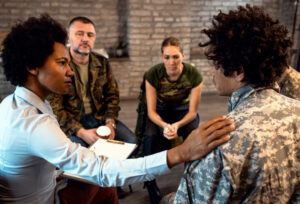Zoom and other video chat apps have become a part of life for millions of people since the pandemic began. Doctor visits, work meetings, church sermons, and school classes were all moved online to lower the risk of spreading the virus through your community. Restrictions are beginning to ease up in many states and cities, which means support group meetings and other resources you rely on will now start to transition back to in-person.
You may feel intimidated by the idea of meeting your group face-to-face without the separating layer of a screen between you, or maybe you have been waiting for this all year and are eagerly trying to figure out what to expect.
How are In-Person Meetings Different?
You will share a relatively small space with several men and women you do not know. There are often refreshments available and a period before and after the meeting when people socialize.
Here is an example of what a 12-Step meeting could look like in person:
- People begin to arrive. There may be refreshments available, and people may socialize as they wait.
- The meeting starts with a brief introduction, and then usually a recitation of the Serenity Prayer. Joining in is optional.
- There may be a reading of some 12-Step material.
- Newcomers are welcomed. At that time, you will have the option of introducing yourself, or you can choose to simply observe. There is no pressure to participate in any aspect of meetings you attend.
- There are several formats the main part of the meeting can take. They could involve members sharing personal stories, or it could be reading more material that is related to the program. Sometimes there is a combination of the two. You will probably be familiar with this from your Zoom meetings.
- Meetings often end with announcements and a prayer or finishing thought.
- People often mingle afterward, chatting and sharing thoughts on the night’s meeting.
While no two meetings or groups are going to be exactly the same, they tend to follow similar formats.
What to Expect from the Location
Each support group meets in a different area, ranging from classrooms to a church sanctuary or business meeting room. Reach out to the group leader to find out what to expect from the meeting location. It is helpful to find out what kind of parking is available in the area so that you know in advance if you will have to pay for parking. Most groups try to make themselves as accessible as possible, so they are often on or near bus lines.
Is There a Meeting Etiquette You Need to Follow?
Most group leaders will inform you of any guidelines before your first meeting. However, there are some accepted etiquette rules similar to those practiced on video chats that include the following.
- Do not interrupt speakers and listen to what they are saying before responding.
- Be respectful of other cultures and their traditions.
- Practice empathy, respect, and compassion
- Anonymity is essential in support groups. Do not pressure other members to share their names or anything else about themselves or their personal life.
- Try to be on time; otherwise, you risk interrupting someone during their moment to be heard
- Respect the boundaries of every member, including preferences surrounding touch and their personal space. Some people require a bigger bubble of space around them to feel comfortable.
- Be polite and treat other members how you would want to be treated
Finding the Right Group for You
Most cities have multiple support groups run by the same or similar organizations to ensure that there are groups available in as many times and central areas as possible. You can try out more than one and see if you feel more comfortable at a specific venue or with a particular group of people. Many people attend multiple meetings each week, and they enjoy the different perspectives.
Anyone who finds themselves not yet ready to get out into social situations has the option to continue attending strictly online meetings all around the country for you to join. Transitioning from a most remote and socially distant way of navigating the world to in-person events may take time for some people, and that is perfectly normal. You can always speak with the group creator about any concerns that you have that might be stopping you from attending. Honest, open communication is the only way to make sure your needs are met and that you have all the relevant information you need to feel comfortable within the group.
In 2020, almost all mental and physical health therapies, meetings, and treatments were altered to stop the spread of Covid-19. Self-help groups moved online, and many people who started their recovery journey after the lockdowns have never attended an in-person therapy session or peer group meeting. Change can be frightening, and understanding what to expect from this new format can help lower anxieties and make the transition easier. Community and group leaders around the world have been working hard to make it safe and easy to start attending in-person events once restrictions ease. At Everlast Recovery Centers, we have remained focused on ensuring that everyone has the resources they need regardless of where they live or what social distancing measures are in place. You are not alone. Soon you will enjoy the deeper connection of meeting peers face-to-face. Reach out to Everlast Recovery Centers for more information. Call (866) 338-6925.




